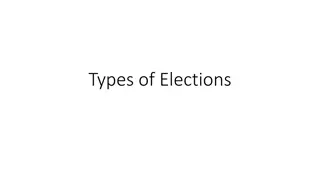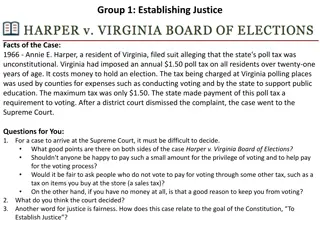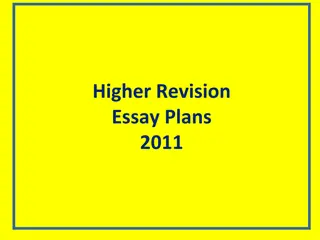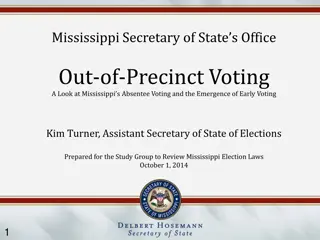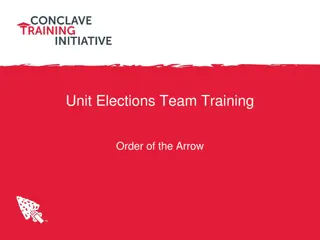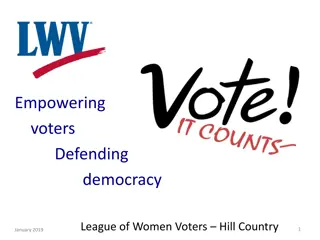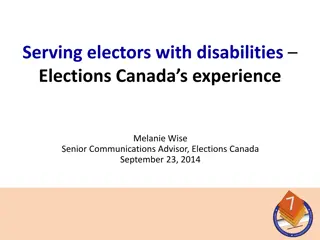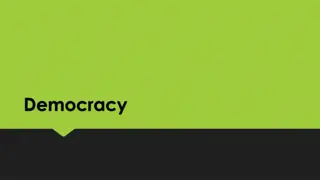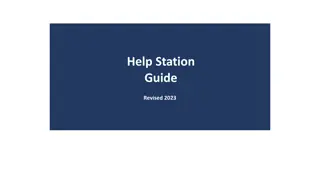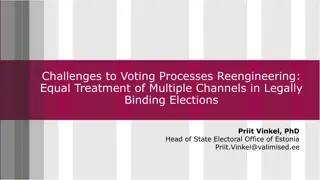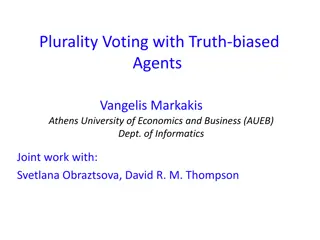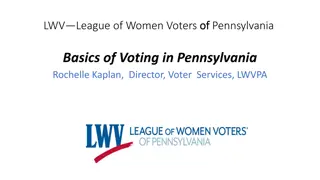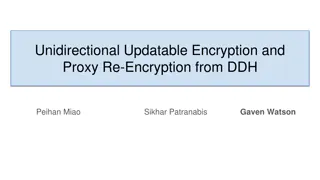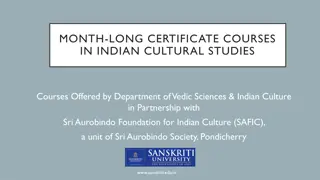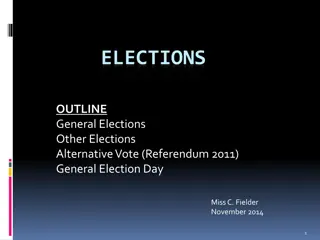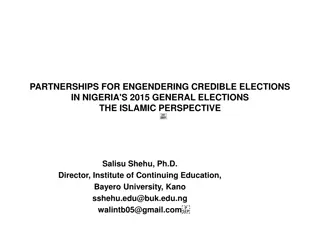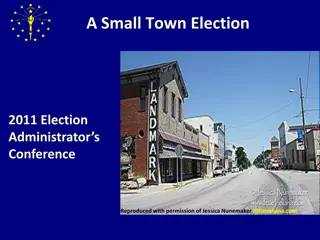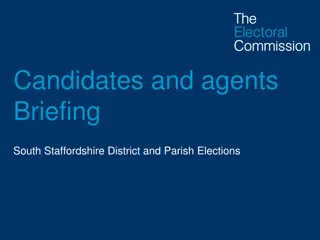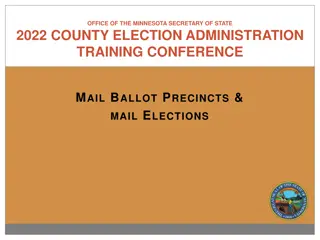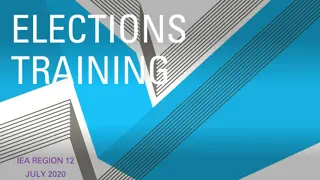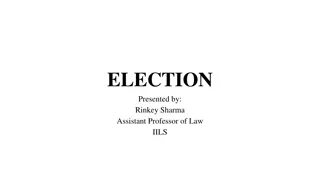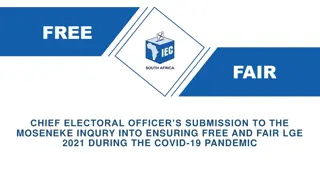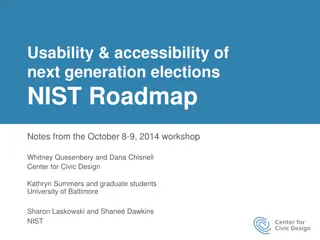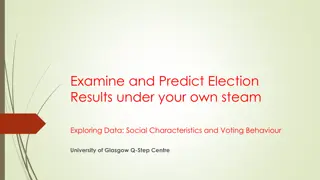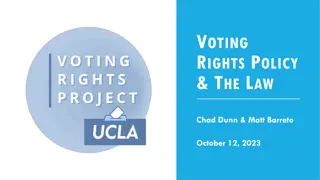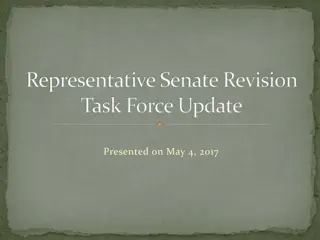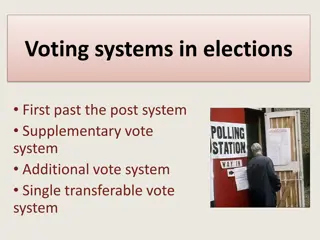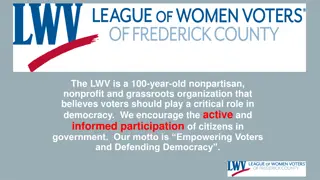Proxy Voting in Indian Elections: Developments and Perspectives
India has seen progress in allowing proxy voting for Non-Resident Indians, with recent proposals to extend this privilege to overseas Indians. The initiative aims to enhance voter participation, especially for those residing abroad. While some political parties support proxy voting, concerns exist regarding the secrecy and security of votes. Various amendments to electoral laws have been proposed to enable proxy voting for overseas Indians.
Download Presentation

Please find below an Image/Link to download the presentation.
The content on the website is provided AS IS for your information and personal use only. It may not be sold, licensed, or shared on other websites without obtaining consent from the author. Download presentation by click this link. If you encounter any issues during the download, it is possible that the publisher has removed the file from their server.
E N D
Presentation Transcript
PROXY VOTING THE CURRENT SCENARIO:INDIA
PROXY VOTING- EARLY DEVELOPMENTS January 2015- The Indian Government informed the Supreme Court of India to accept the Election Commission's recommendation to allow Non-Resident Indians to vote from overseas through e-postal ballots or proxy voting. The decision was based on an October 2014 report prepared by the Election Commission. This decision historically, removes an unreasonable restriction posed by Section 20(A) of the Representation of the People (Amendment) Act of 2010, requiring overseas electors to be physically present in their constituencies to cast their votes. The Election Commission has, however, rejected the plea to allow inter-state migrants to also have options of postal, proxy or e-ballot to enable them vote for their native constituencies. As of January 2014, only 11,846 people living abroad had registered to vote in India. (96.64%) are registered in the State of Kerala and the rest 398 (3.36%) are registered in the States of Punjab (138), Tamil Nadu (112) Puducherry (56), Goa (27), Delhi (13), Haryana (12), Daman & Diu (9), Gujarat (7), Chandigarh & Madhya Pradesh (6 each), West Bengal (4), Chhattisgarh & Himachal Pradesh (2 each), and Andhra Pradesh, Rajasthan, Sikkim, Uttar Pradesh (1 each) but only 8 came ahead and voted.
PROXY VOTING: RECENT DEVELOPMENT The Union Cabinet in August 2017 cleared a proposal to extend proxy voting to overseas Indians by amending electoral laws. At present 24,000 overseas Indians, who are entitled to cast their ballot in India, have registered themselves as voters. While there are no estimates on the number of overseas Indians eligible to vote in India, only 24,348 have registered with the poll panel. Out of these, 23,556 are from Kerala, 364 from Punjab and 14 from Gujarat, according to the data provided by the Commission. For overseas Indians, the Representation of the People Act needs to be amended to include proxy voting as other means to cast their votes. The following amendments will be required under the RPA 1951 which was last amended in the year 2010 by introducing section 20A. This section made special provisions for every citizen of India residing outside the country to enrol them electors provided they had not acquired the citizenship of any other country and were otherwise eligible to be registered as a voter. Apart from that, sections 50 and 60. For Conduct of Elections Rules 1961:Amendment needed in sections 17 (postal ballot), 18, 19, 20 (1) & (2), 22, 21 (1), (2), (3) and from 23-27 will be required. As per the procedure, the elector must first register as a voter, following which he has to appoint a proxy who must be a registered voter in the elector s constituency. Once that is done, the elector can inform the proxy of who he wants to vote for. Non-Resident Indians will have to nominate one proxy for each poll and the intimation about the appointment of the proxy can be sent to the Returning Officer of the concerned constituency. (EC report 2015) The members of MEA and MIOA favored proxy voting as the best alternative. (EC Report 2015)
POLITICAL PARTIES VIEWS : EC REPORT 2015 BJP: Party is in favor of facilitating voting by NRI. INC: 1. 2. 3. 4. 5. 6. First priority to be given to the already registered 12,000 voters. Secrecy of voting to be ensured. Proxy may be prone to pressure. Internet voting is not safe. Postal ballet without attestation could be misused. Voting in person is the most suitable option. BSP: Not represented.
Proxy Voting: A Global Perspective The first use of external voting appears to have been put in place by the Roman emperor Augustus, who invented a new kind of suffrage under which the members of the local senate in 28 newly established colonies cast votes for candidates for the city offices of Rome and sent them under seal to Rome for the day of the elections. In proxy voting an overseas absentee voter is allowed to appoint his/her proxy to vote in person in his/her country of origin. In present times, among the countries subject of this study, only the United Kingdom allows proxy voting Some countries use a combination of different voting methods to ensure greater participation of overseas voters in the electoral exercise. Seven countries subject of this study, namely: Australia, Indonesia, Lithuania, New Zealand, Philippines, Thailand and Portugal, use both in-person voting and postal voting for overseas voting. In the case of Australia, it is the choice of the overseas voter whether he/she votes in person or applies for a postal ballot. In the Philippines, where overseas voting is a very recent experience, postal voting was allowed on an experimental basis for overseas voters in countries with efficient postal systems, such as Canada, United Kingdom and Japan, in the May 2004 elections. The expansion or restriction of the use of postal voting for future Philippine elections is under evaluation.
THE INDIAN DAISPORA :POLITCAL DOMINANCE At present 24,000 overseas Indians, who are entitled to cast their ballot in India, have registered themselves as voters. While there are no estimates on the number of overseas Indians eligible to vote in India, only 24,348 have registered with the poll panel. Out of these, 23,556 are from Kerala, 364 from Punjab and 14 from Gujarat, according to the data provided by the Commission. State Wise number of NRI electors GE 2014 (Highest) out of 11,448 State Wise participation of NRI electors 2014 State Wise Voter Turnout (General including NRI) 2014 Kerala- 12585 Gujarat-4 Uttar Pradesh-138672171 Punjab -169 Chandigarh-2 Maharashtra-80651094 Tamil Nadu- 125 West Bengal -1 Andhra Pradesh-64887809 Puducherry- 65 Rajasthan-1 Bihar-63723810 Goa-27 Tamil Nadu-55042876 Gujarat- 11 Madhya Pradesh-48090968
INDIAN MIGRATION: RECENT TRENDS The leading Indian states for outward labour migration, in 2014, included Uttar Pradesh, Bihar, Tamil Nadu, Kerala, Andhra Pradesh, West Bengal, Punjab, and Rajasthan. Together, these states accounted for over 80% of the migration from India at 678,644 outward migrants. Uttar Pradesh was the top contributor at 230,000 outward migrants showing a new trend of decrease in the rate of presence of the Keralites in GCC as compared to 2014 report. Bihar is at the second position to send out workers to these countries. GCC continues to dominate as the preferred location for un-skilled and semi- skilled labourers. Eg, Saudi Arabia was the most popular destination for Indian migrants in 2015, with a total of 2.8 million Indians migrating to the country, due to ease of availability of jobs to unskilled labour along with higher wages compared with India. Numbers of Indian immigrants in the U.A.E. have also slowed dramatically in the past five years, rising only 20% from 2010 to 2015 compared with an increase of 126% between 2005 and 2010. The number of Indian men choosing to live abroad rose 18% from 8.5 million in 2010. The number of women doing the same thing rose 15% from 4.8 million in 2010 to 5.5 million in 2015.
The states of Uttar Pradesh, Bihar, Haryana and Rajasthan accounted for over 370,000 emigration clearances in 2014. Bulk of these clearances was for the Middle East region. The migrants from these states are majorly unskilled and engage in jobs in the construction and retail industry The states of Kerala, Andhra Pradesh, Telangana, and Tamil Nadu accounted for over 240,000 emigration clearances in 2014. Bulk of these clearances was for the EU, Australia, US, and the Middle East. The migrants from these states are majorly semi- skilled and engage in jobs in the healthcare, retail, and manufacturing industry. The states of Maharashtra and Karnataka accounted for over 34,000 emigration clearances in 2014. Bulk of these clearances was for EU and the US. The migrants from these states are majorly skilled and take up jobs in the information technology industry. The states of Gujarat and Punjab accounted for over 56,000 emigration clearances in 2014. Bulk of these clearances were for the US, Australia, Malaysia, and Singapore. The migrants from these states are majorly entrepreneurs, looking to move to other countries to set up their businesses. http://timesofindia.indiatimes.com/india/58000-indians-issued-emigration- clearance-for-jobs-in-gulf-in-2-years/articleshow/56008497.cms The states of West Bengal, Odisha, and North East India accounted for over 70,000 emigration clearances. Bulk of these clearances was for the Middle East, Australia, Singapore, and Malaysia. The migrants from these states are majorly semi-skilled and engage in jobs in the hospitality and retail industry.
Compiled by the author from various Annual Reports of the Ministry of Labour and Ministry of Overseas Indian Affairs, Government of India.
INDIAN DAISPORA: CURRENT SCENARIO 1. There are approximately 26 million Indian citizens currently residing outside India as per the data compiled by the Ministry of External Affairs. These numbers have the potential to affect the election results if NRIs do vote in large numbers. With 10 million Indian citizens staying abroad, and with 543 Lok Sabha constituencies, it comes to an average of 18000 such voters per constituency. These additional votes, if polled, will have a significant impact on the result. Kerala, Punjab and Gujarat are three States that have a major expatriate population and the experiment would have a great bearing on the election process in these States. 2.
INDIAN DAISPORA IN THE GULF COUNTRIES 1. Education -Largely less educated, relatively young and unmarried. They normally come from rural and comparatively poor economic background. Employment -Largely unskilled labour employed in construction companies, municipalities agricultural farms domestic workers and as housemaid; skilled and semi-skilled workers employed as craftsman, driver, artisan and other technical workers; white-collar or professionals such as doctors, engineers, accountants, nurses, and paramedics, employed in government, private sectors and entrepreneurs. Although recent trends show return of a large number of Malyalis back to the native state to invest in their own state and family. Indian workers emigrating to 6 Gulf nations declines by 34.6%, remittances fall. Political Views-Workers are politically very much interested in Indian politics. According the many leaders of the Labour Union in GCC claim that the workers face hard time to register online at the Election Commission website since the passports are usually seized by the employees. It s not feasible for the workers to travel especially for voting Demands if any-Exploitation by employers, unregulated private recruitment agencies involving in malpractices, and resultant increase in illegal migration. The average NRI death toll in the six Gulf countries (69.2 per 100,000) is much higher than in the rest of the world. The possible reason stated is that Indians living in the West generally work in the technology and financial sectors (whereas most Indians go to the Gulf nations to work in high-risk jobs such as construction). 2. 3. 4.
5. Views on Proxy Voting -A cross-section of Indian expatriates in the UAE welcomed Indian Government s decision to give Non-Resident Indians (NRIs) the right to vote from abroad in elections in India through proxy voting but instead of majority of people consider postal ballet as a better option to promote regular voting patterns apart from the fact they are happy that they will be able to participate in the Indian elections. They also demand Aadhar linked identification code for easy e-voting.
INDIAN DAISPORA IN THE US The Indian diaspora in the United States is a hugely diverse community. Although it is dominated by Hindi and Gujarati-speaking groups, communities of Hindus, Christians, Muslims, Sikhs, Jains, Buddhists, Parsis, and Jews from India have established their religions in the United States. According to 2012 Pew Research Center, 51% Consider themselves Hindus, 20% as Christians (Protestant 11%, Catholic 5%, other Christian 3%), 14% as Unaffiliated, 10% as Muslims, 5% as Sikh, as Jain. Unaffiliated is generally those who were raised as Hindus but aren't really practicing in the traditional sense. In 2014, India was the largest source of new immigrants to the United States and the second largest source of total immigrants. Providing over 147,000 new immigrants in a single year, India was a bigger source than China (about 132,000) and Mexico (about 130,000). Education :Highly educated with most of them acquiring white collar jobs. Many are at a financially secure position. Employment :In terms of employment, even though it constitutes less than one percent of the total American population, it accounts for about ten percent of all doctors and more than five percent of scientists, engineers and IT professionals in the country. Indian Americans are also a relatively young population. Indian immigration flows to the United States have been shaped by temporary admissions for skilled workers and.
students, and as a consequence high-skilled individuals are overrepresented among the India-born population in the United States relative to India s national population, the U.S. foreign-born population, and the U.S. general public. Indians entered the United States 1.8 million times as temporary workers and 819,000 times on student visas during the decade from fiscal year Political Views: Workers are politically very much interested in Indian politics. There are evidences that show a large presence of Hindutva gathering and politics in the form of financial aids to Hindutva candidates contesting for elections in India. Presence of a largely Hindutva dominated community supporting the ideology of BJP and Prime Minister Narendra Modi. On the other hand, visible protests by the Kashmir s and Sikh community in USA demanding for separate country. Views on Proxy Voting :A large section of Indian Diaspora community welcomed the Indian Government s decision to give Non-Resident Indians (NRIs) the right to vote from abroad in elections in India through proxy voting but instead of majority of people consider direct voting as a better option to promote regular voting patterns apart from the fact they are happy that they will be able to participate in the Indian elections. GOPIO has also suggested that a proper representation must be provided to NRIs in the Indian Parliament. One option could be by abolishing the reserved seats for Anglo- Indians since they are already well integrated settled in the Indian society and those seats are reserved for the unrepresented Indian citizens living outside India.
THE INDIAN DIASPORA IN ASEAN COUNTRIES BRUNEI Around 4000 Indian construction and other manual workers largely went to Brunei in the last decade on a relatively short term basis. Around 2500-3000 Indians hold white collar jobs. Tamils, Muslim and Hindus comprise the Indian community. Demands of the Diaspora include: Dual citizenship, faster issuance of passports, introduction of more number of flights from Brunei to Chennai, as most of them are Tamilians and establishment of NRI welfare fund. CAMBODIA Relatively small Indian community. Over 1500 Indians residing in the region. INDONESIA The members of the Indian community who came and settled in 60s and 70s, invested in textile industries. 300,000 Indian population (2017) Presence of the Sindhi community in Textiles, IT industries and Punjabi community in good sports business in Jakarta. Other professions include medical, law and accounting.
ECAII formed by the Indian community is very active in terms of trade. The Sindhis have their own community. LAO PDR Most of the members of the Indian community are Tamilians. The 150-strong Indian community has grown in profile.There are few Sindhis. There are about 18 PIOs residing. 70-80% are Muslims. Jewelers, restraunters and textile industry are mostly dominated by the Indian community. Demands include dual nationality, tax benefits for income earned in Lao MALAYSIYA More than 1.6 million Indians live in the region. Ethnic communities include 80% Tamilians followed by Keralites, Andhraites, Punjabis, Sindhis, and Gujaratis. Major portion of the community engaged in rubber and palm plantations others either in food, police and railways. Since major chunk is involved in labor, education takes a back seat. Communities taking part in the infrastructure-ports, highways. Demands include assistance and improvisation in complex legal systems and immigration laws for illegal employment as laborers in plantations and construction sites in terms of wages, hurdles in terms of bureaucracy in business ventures and direct flight from Kaula Lampur to Cochin.
MYANMAR More than 25 lakh Indian origin which only 2000 hold Indian passports. 13 lakh- Muslims,8 lakh Hindu and 4 lakh Christian and Sikhs. Between 2 to 4 lakh are stateless. Most PIOs are jobless and work as domestic workers mechanics and construction workers. In the rural areas, farming is being practiced largely from Bihar. Demands include: Stateless situation, granting citizenship, compensation and nationalized land holdings. THE PHILIPPINES Majority of the Indian community is settled in Manila(approx 8,963-2012) Sindhi community are engaged in trade and manufacturing whereas the Punjabi community deal with money lending. Demands include: dual citizenship, long term/permanant residence status for spouses. SINGAPORE 357,000 ethnic Indians. 64% Tamil and is one of the official languages. Other communities include Sindhis, Punjabis and Guajarati. Demands include: educational facilities, simplification of rules, development of infrastructure, dual citizenship easing of property acquisition, stricter immigration laws, delayed payment of wages, stealing of passports by the employers, unpaid IT professionals, labor problems including claims, forged passports, (maids, laborers etc)
THAILAND Almost all Indians are found in the urban centers of Thailand. Largest community is of the Sikh community between 30-35000 and followed by the Hindus from West Punjab- Pakistan. Largely Well established community mainly involved in textiles, real estate or jewellery. Are mostly rich. Demand include: Members who are detained illegally face severe issues, arbitrary termination of contract, delay in payments for those working in Thai companies, recognition to Indian educational institutes. VIETNAM Indian community (more than 2000 as per 2011 census) largely situated in Ho Chi Minh city and Hanoi. They are well educated and work as professionals. Demands include: enhancing bilateral trade, shipping services and air flights between Vietnam and India.
KERALA :RELEGIOUS COMMUNITIES Numerically, at present, the Christians are the smallest among the three major religious groups in Kerala. The Christians were 18.4 percent of the total population of the state in 2011 whereas the Muslims, with 8.9 million, were 26.6 percent in 2011. The 6.141 million Christians in 2011 consists of 3.744 million Catholics (61.0 percent of the total Christians), 977,000 Jacobite/ Orthodox Syrians (15.9 percent), 405,000 Mar Thoma Syrians (6.6 percent), 274,000 Church of South India (CSI) adherents (4.5 percent), 214, 000 Pentecost/ Church of God members (3.5 percent) and 160,000 Dalit Christians (2.6 percent). The most numerous among the Christian denominations in Kerala today are the Syro-Malabar Catholics Among the Hindus, the most numerous caste is the Ezhava community with a population of 7.215 million in 2011. They are followed by the Nairs who constituted a little under 4 million in 2011. The Scheduled Caste/Tribe is an important group among the Hindus. They number about 3.2 million and were 17.5 percent of the Hindu population in 2011. The Sunnis are the largest religious community not only among the Muslims but also among all religious communities in Kerala. Numbering about 8.324 million in 2011, they constitute nearly 94 percent of the Muslim religious group and 25 percent of the State s total population.
EXTERNAL MIGRATION The number of Kerala emigrants living abroad in 2014 is estimated to be about 24.0 lakh whereas The number of Kerala migrants who returned from abroad (REM) is 12.5lakhs in 2014. Geographic distribution by district of origin shows that the largest number of emigrants originated from Malappuram district, a position it retained throughout the entire 1998-2014 period. However, its share of the pie has shrunk somewhat in recent years, from 21.8 percent in 1998 to 19.0 percent in 2014. The principal destination countries of Kerala emigrants have remained more or less unchanged over these years, with nearly 90 percent of the Kerala emigrants going towards the Gulf countries. Within the Gulf region, the UAE retained its number one rank, with Saudi Arabia coming in the second position. Nearly 38 percent of Kerala s emigrants live in the UAE and 22 percent live in Saudi Arabia. In the last 3 years, especially, after the Nitaqat crisis, Saudi Arabia has lost about 3 percentage points in its share.
INTERNAL MIGRATION Karnataka was number one in 2008 and 2011; it remained number one in 2014 also, with 33 percent of the state s internal migrants (an increase of 4.2 percentage points during 2011-14).Tamil Nadu and Maharashtra are the other two major states where Kerala out-migrants have made a living. Education and Employment Migrants, especially external migrants, from Kerala are predominantly males .The proportion of population in the age group 20-29 years was only 15.9 per cent among the general population, but was as high as 29.1 per cent among the emigrants and 39.8 per cent among the out-migrants. Only 45.2 percent of the total population (15+ years) have passed the 10thstandardor have higher levels of education, as much as 75.1 percent of the emigrants and 78.2 percent of the out-migrants have passed10th class or higher levels of education. With regards to gender, religious and spatial distribution of student migrants, 63 percent of the student migrants were males, 49 percent were Hindus, 43 percent were Christians and 8 percent were Muslims. The principal district of origin of student migrants in 2014was Kottayam and Pathanamthitta districts, keeping with the earlier trends.
REMITTANCE NRI deposits in Kerala have now crossed the magic mark of Rs 1 lakh crore, soaring by more than 17% from Rs 93,884 crore to Rs 1.1 crore (at the end of 2014- 15) in the space of just one year, according to data collected by the state level bankers committee (SLBC). This includes money from all parts of the world. Kerala government survey showed that remittances sent by the diaspora support at least 50 lakh people in the state, which has a population of 3.15 crore. As per the State government data, he maximum number of Keralites, around 5.73 lakh, reside in the UAE and around 4.50 lakh in Saudi Arabia. Many have been migrating to the US and Europe in the last decade. In the US, there are over 78,000 Keralites, while in Europe there are nearly 53,000. Canada has close to 10,000 Keralites. Families have also migrated to the Africa with nearly 7,000 Keralites residing in different parts of the continent. The Muslim-dominated Malappuram district has the highest number of people living off remittances, around 2.9 lakh. Around 58,500 women from Kerala today work as nurses and Kottayam district has the maximum number of women working abroad.
ELECTIONS IN KEREALA AND THE INFLUENCE OF THE NRI COMMUNITY GE ELECTIONS 2014 STATE ASSEMBLY ELECTIONS 2016 VOTER TURNOUT %-73.9399958481747 VOTER TURNOUT %-77.35 OVERSEAS ELECTORS- 12585/0 OVERSEAS ELECTORS-23,289/ ELEGIBLE VOTERS - 24.25 million ELEGIBLE VOTERS -26 million If proxy voting happens in India, this move is likely to have a huge impact on elections in states like Kerala, a highly politicised community which has nearly 10% of its population living abroad, 98% of registered overseas voters helping its economy sustain through remittances but having no say in elections. The expected constituencies that would be affected are: Nadapuram (CPM), Perambra (CPM), Kuttiadi (IUML), Palakkad (INC) and Varkala (CPM). During the state elections 2016, several overseas voters, especially from north Kerala, came to the state to cast their franchise. The strength of the overseas electorate was 23,289. Kerala voters from the neighbouring states of Tamil Nadu and Karnataka also reached the state to exercise their franchise. .
Indian Union Muslim League leader P K Kunhalikutty wins the Malappuram by election in Kerala by 171,023 lakh votes. The by-elections were held on April 12. Communist Party of India (Marxist) candidate, MB Faisal managed to secure only 3,44,307 votes. BJP candidate ADV. N. SREEPRAKASH has got 65,675 votes. (The Muslim-dominated Malappuram district has the highest number of people living off remittances, around 2.9 lakh-2014 data). Kuttiadi, for long a fortress of the Communist Party of India (Marxist), produced the biggest surprise of the 2016 Assembly election when Parakkal Abdullah, of the Indian Union Muslim League, won the seat by a thin margin of 1,157 votes for which he thanked the NRI community to fly down in majority to vote for him and his party.
PUNJAB: RELEGIOUS COMMUNITIES According to the 'Population by Religious Community' figures of Census 2011 released in 2015, of the total 56,83,894 Hindus, 33,78,052 reside in urban areas and a lesser number of 23,05,842 are in villages. In case of Sikhs, 1,23,48,455 are residing in rural areas against 36,56,299 living in cities of the state. The Muslim population too is concentrated in rural areas with 2,78,825 settled there and a slightly lesser 2,56,664 in urban parts of Punjab. Muslims (5,35,489) constitute 1.93% of the total population while Christians (3,48,230) are 1.26% of the total count in Punjab. The percentage of Sikh population in Punjab has registered a decline from 59.9% to 57.69%, even though the total population of the community has gone up. The decline in the percentage of Sikh population may have political ramifications in the state and it could be due to a variety of reasons like migration of the community to other countries. Punjab has the distinction of being home to the largest proportion of scheduled castes population (29 per cent, according to 2001 census, as opposed to national average of 16 per cent) who have a negligible share in the ownership of land. Not only have the landless Dalit Sikhs been dependent on big landowning Jat farmers for farming employment, they were also treated unequally in the Jat Gurdwaras.
EXTERNAL MIGRATION 81 per cent of people migrating from Punjab to foreign countries come from the state's villages, contrary to popular perception, about 45 per cent of people are headed to Gulf countries, while Canada remains second most favoured destination.If the process of migration goes on with such a speed then it will reduce the Sikhs into minority also Punjabi speaking population will go to the minority in this state. People in rural areas mostly leave while they are in their early twenties, the latest study says but they don't send money in the same way and their general behaviour is different like Kerala. Migrant labour to Punjab had speeded up in 1960s. Since punjabi farmers have lost interest in manual labour because all classes gained cash share from huge farm production. For the reason of that Punjab becomes an attraction for the migrant labour from non-Sikhs of other states .As compared to their home states they get high labour rates in seasons and job opportunities in all times.
PUNJABI DIASPORA Punjabi Diaspora is one of the oldest of the free Indian regional Diasporas with a history of over 125 years. It is predominantly located in the three economically advanced countries of the USA, the UK and Canada. The UK-based Punjabi diaspora s engagement with India and its home state of Punjab is mainly through household level remittances and village/district level social and charitable projects, primarily in the health and education sectors. There is little engagement through industrial ventures and larger commercial initiatives. The current strength of Punjabis is estimated at almost half a million and this is reflected by their presence in all aspects of Canadian life. Besides a number of Members of Parliament from BC and Ontario provinces where they are overwhelmingly settled, Punjabis have established themselves in many kinds of economic activities from estate agents to manufacturing gaining employment in health and education sector and the media and arts. Significantly, Nikki Haley Randhawa, the US representative to the UN, had visited Punjab in November 2014 in her capacity as governor of South Carolina. She had met with then-deputy chief minister Sukhbir Singh Badal and discussed avenues of cooperation including areas like skill training. Punjab s diaspora in California should be tapped for strengthening cooperation in areas like agriculture, educational linkages and even skill development.
ELECTIONS IN PUNJAB AND THE INFLUENCE OF THE NRI COMMUNITY GE Elections 2014 NRI Voter turnout VOTER TURNOUT -19527114 (70.6312845962454) ELIGIBLE VOTERS-19608161 VOTER TURNOUT-2 (Chandigarh) ELIGIBLE VOTERS-169 Lok Sabha Elections-2014 States with close Margins State Winning Party Hoshiarpur(SC) BJP (13582) Ludhiana(GEN) INC (19709) Bathinda(GEN) SAD (19395) Patiala(GEN) Anandpur Sahib(GEN) Firozpur(GEN) AAAP (20942) SAD (23697) SAD (31420)
STATE ASSEMBLY ELECTIONS 2017 CONSTITUENCY WINNER Hoshiarpur (SC) INC (11233) Ludhiana(GEN) INC (20480) Bathinda(GEN INC (18480) Patiala(GEN) Anandpur Sahib(GEN) INC (52407) INC (23881) Firozpur(GEN) INC (29587)
GUJARAT RELIGIOUS COMMUNITIES With a Population of 67,600,992 Gujarat is the 10th largest state in terms of Population in India. Hinduism is the most dominant religion in Gujarat with 89.1% of the population being Hindus. The other religions include Muslims 9.1%, Jain and Sikhs 0.1% of the total Population in Gujara. In five years, the state government received 1,838 applications from people of various religions to convert to another religion, Of them, 1,735 applications (94.4%), 57 Muslims, 42 Christians and 4 Parsis have applied for permission to convert. The Muslim community has registered a moderate 0.8 per cent growth to touch 17.22 crore in the 10 year period between 2001 and 2011, up from 13.8 crore, while Hindus population showed a decline by 0.7 per cent at 96.63 crore during the period, the census data said.
EXTERNAL MIGRATION Lots of studies have been done on Gujarati Diaspora but not much is done on socio- cultural dimensions of life in host country and its impact in country of origin. Most migrants wanted to permanently settle in England and Canada. Primary cause of immigration and settlement in host country is by economic reasons like economic inconvenience and less employment opportunities with low job securities. However it does not imply their dislike for their tradition, social structure and culture of natal community, which they are still preserving in host countries. Encouraging factor for immigration and settlement of respondents was due to supporting family, kinship and caste networks in host countries. And their (NRGs) status of being successful in country of origin. Gujarat Diaspora accounts for only 1.3 % in 2013 and majority of them migrate to UK, USA, Canada and Australia. Muslims prefer to migrate to Gulf Countries to work in the oil companies and non Muslims prefer the west. Gujarat receives less of remittance for household consumption. A majority of resources is in the form of philanthropy towards religious activities which seems to reinforce social divisions. .
ELECTIONS IN GUJARAT AND THE INFLUENCE OF THE NRI COMMUNITY GE Elections 2014 NRI Voter turnout VOTER TURNOUT (general)-40578577 (63.6642336507081) ELIGIBLE VOTERS-40603104 VOTER TURNOUT-4 ELIGIBLE VOTERS-11 Lok Sabha Elections-2014 States with close Margins State Winning Party Anand BJP (63,426) Sabarkantha BJP (84,455) Bardoli BJP (123,884) Junagadh Patan Amreli BJP (135,832) BJP (138,719) BJP (156,232)


